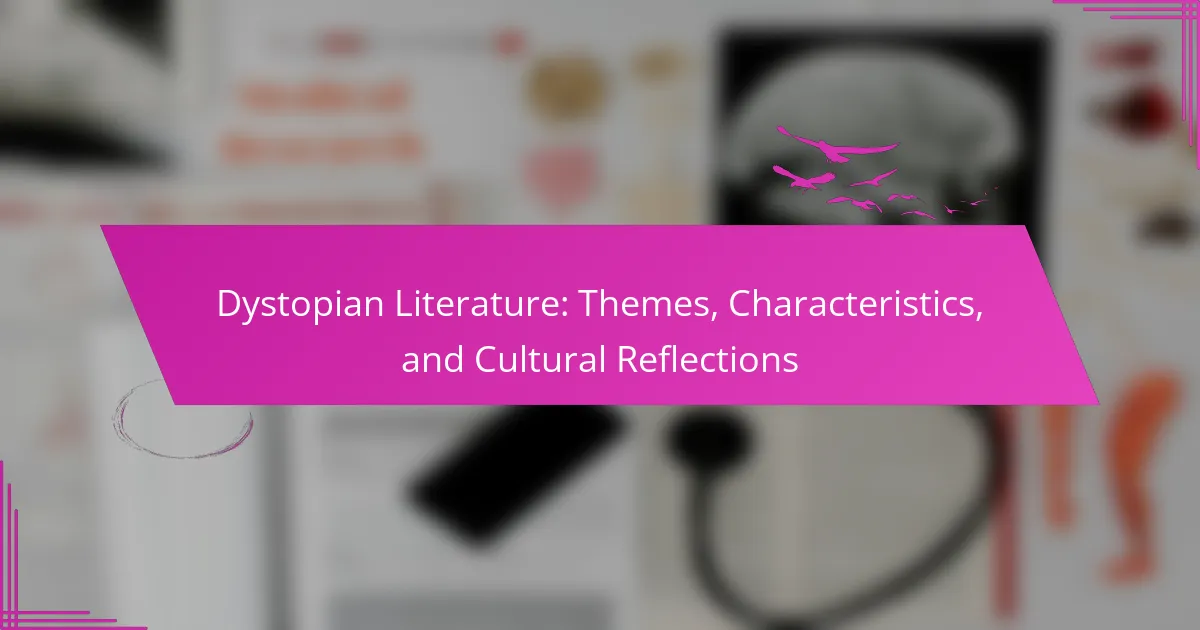Dystopian literature serves as a powerful lens through which we can examine societal fears and critiques of power structures. This article explores key themes such as oppression, surveillance, and environmental collapse. It also highlights common characteristics like totalitarianism and social inequality. Lastly, it addresses emerging trends and critiques, offering insights into the evolving landscape of dystopian narratives.
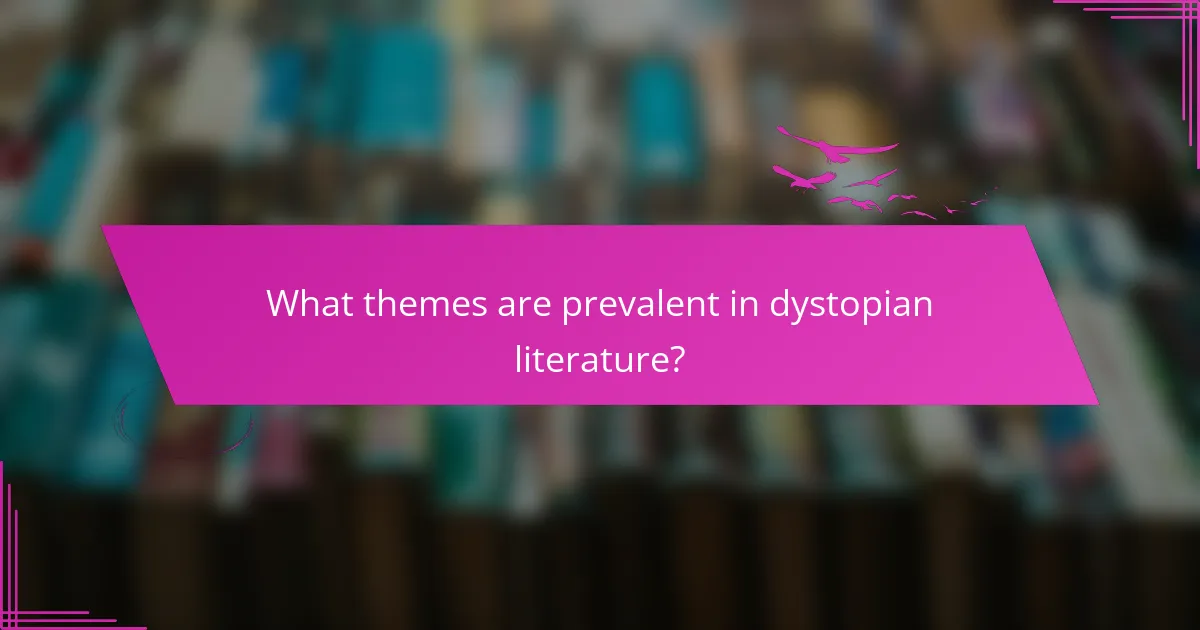
What themes are prevalent in dystopian literature?
Dystopian literature often explores themes of oppression, surveillance, environmental collapse, and loss of individuality. These narratives reflect societal fears and critiques of power structures.
Common themes include totalitarianism, where governments exert extreme control over citizens, and the consequences of technology on humanity. Environmental degradation is another prevalent theme, highlighting the impact of neglecting nature.
Additionally, dystopian works frequently address social inequality, portraying stark divides between classes. The struggle for freedom and identity remains central, as characters navigate oppressive regimes or societal collapse.
These themes resonate with contemporary issues, making dystopian literature a powerful tool for cultural reflection and critique.
How do societal fears shape dystopian narratives?
Societal fears significantly shape dystopian narratives by reflecting collective anxieties. These narratives often explore themes like government overreach, environmental collapse, and technological control, mirroring contemporary concerns. For instance, the rise of surveillance in literature echoes fears of privacy erosion. Moreover, dystopian settings serve as cautionary tales, warning against societal complacency. As a result, these narratives resonate with readers, providing a lens to examine current issues and potential futures.
Which ethical dilemmas are explored in dystopian settings?
Dystopian literature often explores ethical dilemmas such as individual freedom versus state control, the morality of surveillance, and the consequences of technological advancement. These narratives challenge readers to consider the implications of sacrificing personal liberties for societal safety. Themes of oppression, identity, and moral ambiguity frequently arise, prompting critical reflections on contemporary societal issues. Through these dilemmas, dystopian stories reveal the complexities of human nature and the ethical boundaries of governance and technology.
What role does technology play in dystopian worlds?
Technology serves as a tool of oppression and control in dystopian worlds. It often manifests through surveillance, manipulation of information, and automation, shaping societal structures. For example, in George Orwell’s “1984,” technology enables constant surveillance, stripping away privacy and autonomy. The use of advanced technologies can highlight themes of dehumanization and loss of individuality. In contrast, some narratives explore technology as a means of resistance, showcasing characters who leverage it to challenge oppressive systems. This dual role reflects cultural anxieties about technological advancement and its implications for freedom and identity.
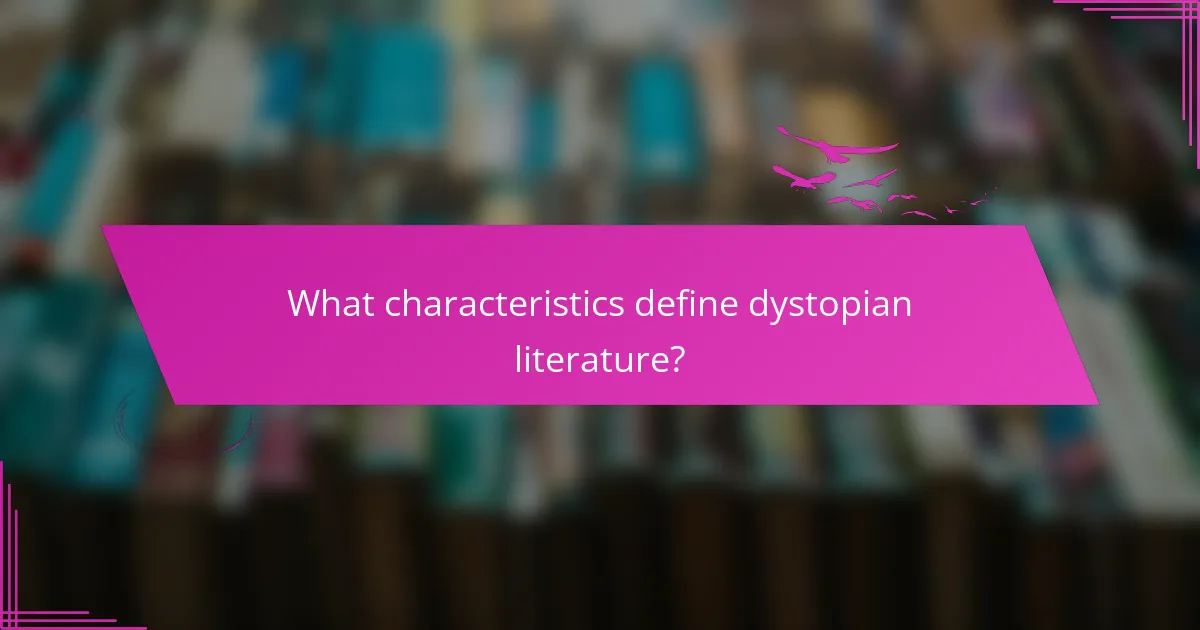
What characteristics define dystopian literature?
Dystopian literature is defined by themes of societal control, surveillance, and loss of individuality. It often explores the consequences of extreme political ideologies and technological advancements. Common characteristics include oppressive governments, environmental disasters, and dehumanization. These narratives reflect cultural anxieties and provoke critical thought about current societal trends.
How is world-building essential to dystopian storytelling?
World-building is essential to dystopian storytelling as it creates immersive environments that reflect societal fears and challenges. It establishes the backdrop against which characters navigate oppressive systems, enhancing themes of control, resistance, and survival. Detailed settings amplify emotional impact and provoke critical thought about real-world issues. For example, the bleak landscapes in works like “1984” or “The Handmaid’s Tale” serve as powerful metaphors for the consequences of totalitarianism. Effective world-building deepens reader engagement, making the narrative’s critique of contemporary society more resonant.
What narrative techniques are commonly used in dystopian works?
Dystopian literature often employs narrative techniques such as unreliable narrators, non-linear timelines, and symbolism. These methods enhance themes of oppression and societal critique. Unreliable narrators create ambiguity, leaving readers questioning reality. Non-linear timelines illustrate the chaotic nature of dystopian worlds. Symbolism conveys deeper meanings, enriching the narrative’s emotional impact.
Which character archetypes frequently appear in dystopian fiction?
Dystopian fiction frequently features character archetypes such as the rebel, the oppressed, the authoritarian leader, the savior, the skeptic, and the survivor. These archetypes reflect societal fears and cultural tensions. The rebel often challenges oppressive systems, while the oppressed represents the populace under control. The authoritarian leader embodies the oppressive regime, and the savior seeks to restore hope. The skeptic questions the status quo, and the survivor navigates the harsh realities of dystopian worlds. Each archetype serves to explore complex themes of power, resistance, and human resilience.
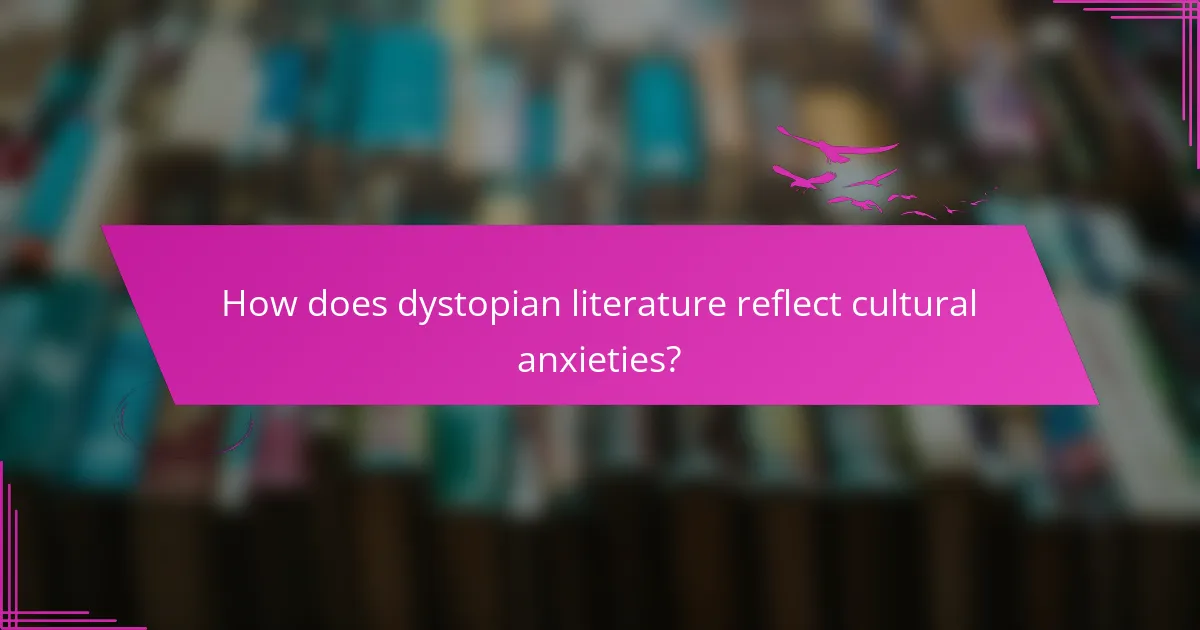
How does dystopian literature reflect cultural anxieties?
Dystopian literature reflects cultural anxieties by portraying societal fears and potential futures. These narratives often explore themes like government oppression, environmental collapse, and technological control. For instance, works such as “1984” highlight concerns about surveillance and loss of individuality. This genre serves as a mirror, amplifying contemporary worries about social justice, personal freedom, and the consequences of unchecked power. As a result, dystopian literature remains relevant, prompting readers to confront their realities and consider the implications of their choices.
What historical events have influenced dystopian narratives?
Historical events such as totalitarian regimes, wars, and technological advancements have profoundly shaped dystopian narratives. The rise of fascism and communism in the 20th century inspired works like George Orwell’s “1984” and Aldous Huxley’s “Brave New World.” These events reflect societal fears of oppression and loss of individuality. Additionally, the Cold War era and nuclear threats influenced themes of surveillance and paranoia in literature. Economic downturns and environmental crises have also prompted explorations of societal collapse and moral decay in contemporary dystopian works.
How do regional perspectives shape dystopian themes?
Regional perspectives significantly influence dystopian themes by reflecting cultural fears and societal critiques. Different locales bring unique historical contexts, leading to varied interpretations of dystopia. For instance, authoritarian regimes may inspire narratives focusing on oppression, while environmental degradation in certain regions highlights ecological concerns. These themes resonate with local audiences, making the literature more impactful. As a result, regional settings shape character motivations and plot developments, enriching the genre’s diversity.
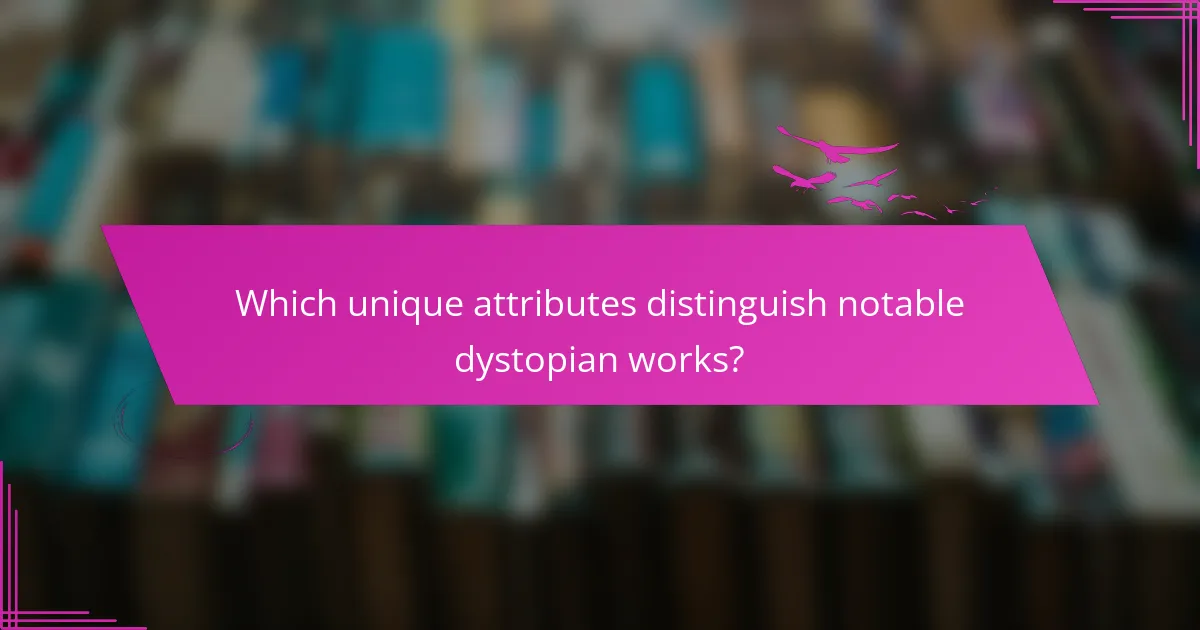
Which unique attributes distinguish notable dystopian works?
Notable dystopian works are distinguished by their unique attributes, including societal critique, psychological depth, and speculative technology. These elements create immersive worlds that reflect real-world issues. For example, George Orwell’s “1984” uniquely explores totalitarianism through surveillance and language manipulation. Margaret Atwood’s “The Handmaid’s Tale” offers a rare focus on gender oppression, highlighting women’s rights. These attributes deepen the thematic complexity and cultural relevance of dystopian literature.
What makes certain dystopian novels timeless classics?
Certain dystopian novels remain timeless classics due to their exploration of universal themes and societal critiques. They resonate with readers by reflecting contemporary fears and aspirations.
Key themes include totalitarianism, environmental degradation, and social inequality. These issues remain relevant, allowing new generations to connect with the narratives.
Character development often highlights individual versus society, creating relatable protagonists facing moral dilemmas. This personal connection enhances the emotional impact of the stories.
Cultural reflections in these novels encourage critical thinking about current societal structures. They inspire discussions on freedom, ethics, and the future, ensuring their place in literary history.
How do author backgrounds influence their dystopian visions?
Author backgrounds significantly shape their dystopian visions by influencing themes, perspectives, and societal critiques. Authors draw from personal experiences, historical contexts, and cultural narratives, which inform their portrayal of dystopian worlds. For instance, George Orwell’s political activism and critique of totalitarianism deeply influenced “1984.” Similarly, Margaret Atwood’s feminist insights and environmental concerns are evident in “The Handmaid’s Tale.” These unique attributes provide depth and authenticity to their narratives, allowing readers to engage with complex societal issues.
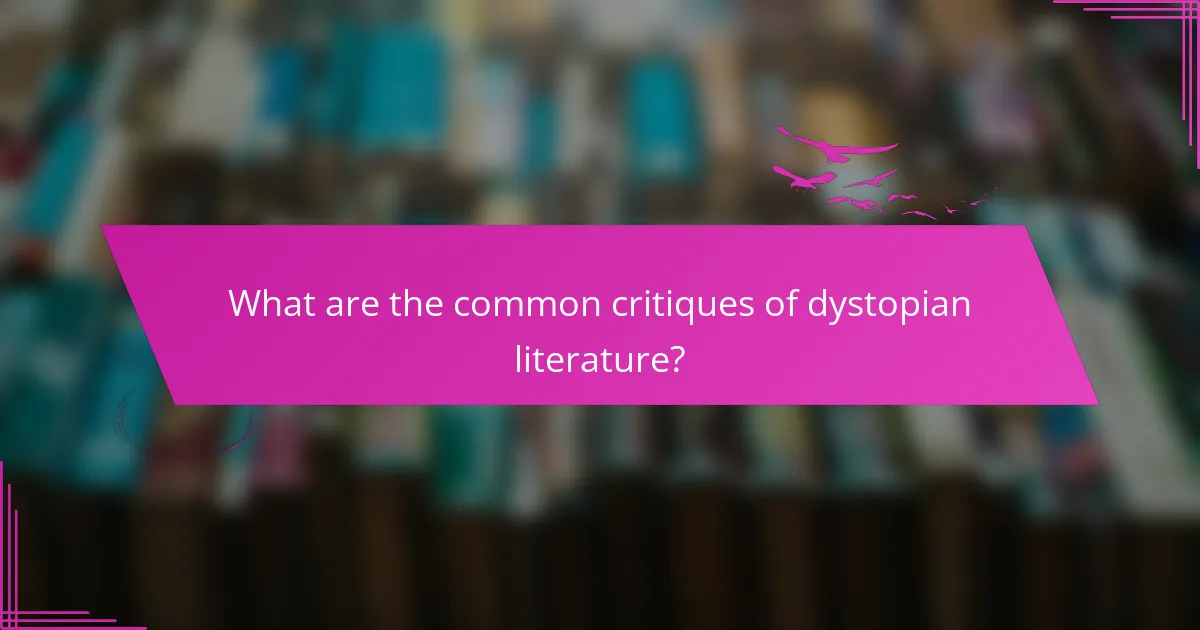
What are the common critiques of dystopian literature?
Common critiques of dystopian literature include its tendency to oversimplify complex societal issues, reliance on clichés, and often bleak narratives that can lack hope. Critics argue that these works may reinforce negative stereotypes or fail to inspire real-world change. Additionally, some believe that dystopian settings can distract from the nuances of contemporary life, leading to a disconnect between fiction and reality. The portrayal of authoritarian regimes may also be criticized for being exaggerated or unrealistic, undermining the genre’s credibility.
How do readers interpret dystopian messages differently?
Readers interpret dystopian messages differently based on personal experiences and cultural contexts. Individual backgrounds shape perceptions of themes like oppression and surveillance. For example, a reader from a totalitarian regime may resonate more deeply with the narrative of control than someone from a democratic society. Additionally, cultural reflections in dystopian literature often highlight societal fears, leading to varied interpretations across different communities. The emotional impact of dystopian settings can evoke a range of responses, from fear to hope, influencing how messages are received.
What are the limitations of dystopian storytelling?
Dystopian storytelling has several limitations that can impact its effectiveness. It often relies on exaggerated scenarios that may feel unrealistic, diminishing relatability. Character development can be sacrificed for plot, leading to one-dimensional figures. Additionally, the focus on societal critique might overshadow personal narratives, making the story feel didactic. Finally, some dystopian works may lack resolution, leaving readers unsatisfied and questioning the purpose of the narrative.
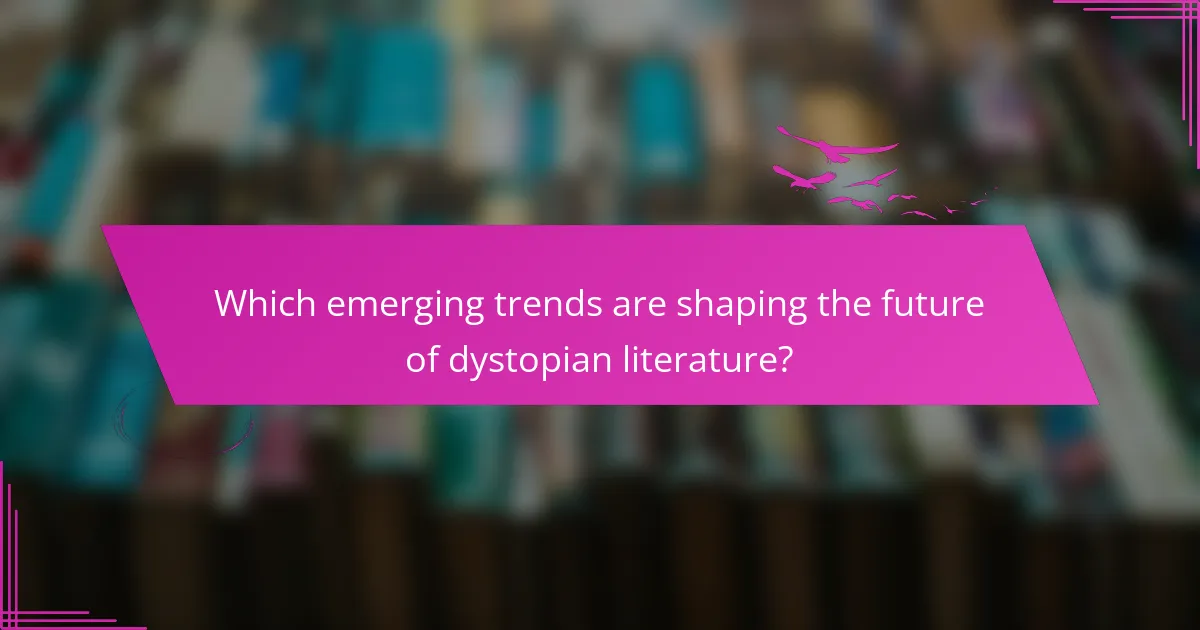
Which emerging trends are shaping the future of dystopian literature?
Emerging trends shaping the future of dystopian literature include increased focus on environmental issues, technology’s impact on society, and the exploration of social justice themes. These narratives reflect contemporary anxieties about climate change, surveillance, and inequality. Authors are blending genres, incorporating elements of speculative fiction and realism to engage readers. Additionally, diverse voices are gaining prominence, offering unique perspectives on dystopian futures.
How is climate change influencing new dystopian narratives?
Climate change is significantly shaping new dystopian narratives by reflecting societal anxieties about environmental collapse. Authors use climate-related disasters to depict futures where ecosystems fail, leading to resource scarcity and societal breakdown. For example, works like “The Overstory” illustrate the consequences of deforestation and climate neglect. These narratives often explore themes of survival, resilience, and the moral dilemmas faced in a deteriorating world. As a result, climate change becomes a unique attribute that drives character development and plot progression in contemporary dystopian literature.
What role do diverse voices play in contemporary dystopian fiction?
Diverse voices enrich contemporary dystopian fiction by providing varied perspectives and experiences. They challenge dominant narratives, fostering deeper engagement with themes of oppression, resistance, and identity. This inclusivity reflects societal complexities, enhancing authenticity and relatability. For instance, authors from marginalized backgrounds often explore unique attributes of survival and resilience, which may differ from mainstream portrayals. This diversity not only broadens the genre but also encourages critical discourse on contemporary issues, making dystopian literature a mirror of our multifaceted world.
What best practices can writers follow when creating dystopian stories?
Writers creating dystopian stories should focus on building a believable world, developing complex characters, and exploring significant themes. Incorporating social commentary enhances the narrative’s depth. Use vivid imagery to evoke emotions and maintain a consistent tone to engage readers effectively. Prioritize conflict and tension to drive the plot forward.
